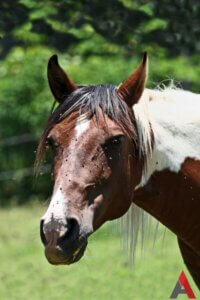
Stable Flies in North Carolina
Stable flies are a common nuisance in North Carolina, particularly in rural and agricultural areas. These little flies are known for their painful bites—and their tendency to disrupt outdoor activities for both humans and our furry friends. Learning about stable flies, what attracts them, and how to eliminate them is essential to maintaining a clean and pest-free home.
What Are Stable Flies?
Stable flies are biting flies that resemble house flies but are distinguishable by their piercing mouthparts. Unlike houseflies, which feed on decaying organic matter, stable flies feed on the blood of animals and humans. They are most commonly associated with livestock, but can also become a problem in residential areas.
You can recognize them by a few unique characteristics:
- Gray bodies with dark spots on their abdomen.
- A distinct needle-like mouthpart used for biting and feeding.
- Painful bites that cause irritation and swelling.
What Attracts Stable Flies
Stable flies thrive in environments rich in organic material, particularly areas where decaying matter builds up. These breeding sites provide the nutrients needed for their larvae to develop and grow.
Livestock Manure
Livestock manure is one of the most common and significant breeding grounds for stable flies. The organic material and moisture found in manure create a nutrient-rich environment where stable fly larvae can thrive.
Farms and ranches are particularly vulnerable, as the large amounts of manure present in these areas provide plenty of opportunities for flies to reproduce. Beyond being a breeding site, manure attracts adult stable flies, which can irritate livestock, reduce productivity, and spread disease among animals.
Rotting Vegetation
Decaying plant matter is another major source of stable flies. Grass clippings left in piles after mowing, damp or rotting hay bales, and poorly managed compost piles offer perfect conditions for stable fly larvae to develop. Rotting vegetation traps moisture and provides plenty of organic nutrients, making it an ideal habitat. Properly disposing of grass clippings, keeping hay dry, and regularly turning compost piles are essential steps in reducing the presence of these pests.
Wet Areas
Moisture is crucial for stable fly larvae to survive, making wet environments another common breeding site. Areas with consistently damp soil, puddles, or stagnant water can quickly become infested with stable flies. Properties near water sources like lakes, streams, or irrigation systems are particularly susceptible.
Where Do You Find Stable Flies in Your House
Although stable flies are more commonly found outdoors, they can enter homes in search of shelter or food. Inside, you might find them:
- Near windows and doors as they try to escape.
- Around areas with organic waste or compost bins.
- Near pet bedding or areas with animal waste.
How to Get Rid of Stable Flies
Controlling stable flies requires a holistic approach: To both eliminate existing populations and prevent future infestations.
Eliminate Breeding Grounds
Stable flies rely on decaying organic material for their larvae to develop, making the removal of breeding sites a critical step in controlling their population. Promptly dispose of manure, rotting vegetation, and compost piles that can harbor fly larvae.
On farms and properties with livestock, regular cleaning of manure and proper compost management are essential. Keep grass clippings and hay dry, and remove any organic debris that can trap moisture and attract stable flies.
Use Fly Traps
Fly traps are an effective way to capture adult stable flies and reduce their numbers. Sticky traps can be placed in areas where flies are commonly seen, such as near barns, trash bins, or outdoor seating areas. Baited traps designed specifically for stable flies are also highly effective in attracting and capturing these pests. Regularly check and replace traps to ensure continued effectiveness.
Install Screens
Preventing stable flies from entering your home or barn is one of the most effective control strategies. Install tight-fitting screens on windows, doors, and ventilation openings to block their entry. Inspect existing screens for tears or gaps and repair them as needed. For additional protection, consider using screen doors with self-closing mechanisms to limit access further.
Maintain Cleanliness
Stable flies thrive in areas with poor hygiene, so maintaining cleanliness is crucial. Regularly clean animal enclosures and remove soiled bedding to eliminate potential breeding sites. Keep trash bins tightly sealed and clean the areas around them to prevent fly attraction. For compost piles, ensure they are properly managed by turning them regularly to accelerate decomposition and reduce fly breeding opportunities.
Seek Professional Pest Control
In cases of severe stable fly infestations, professional pest control services are often the most effective solution. Pest control experts can assess your property to identify hidden breeding sites and implement targeted treatments to eliminate both adult flies and larvae.
Frequently Asked Questions
Are stable flies common in North Carolina?
Yes, stable flies are common in North Carolina, especially during warmer months. While stable flies are often confused with horse flies, they are a distinct species with different behaviors and breeding habits.
What states have stable flies?
Stable flies are found across the United States but are most prevalent in regions with livestock or agricultural activity. They thrive in areas with warm temperatures and abundant organic material. Expect to see these pests prevalent seasonally in the spring, summer, and early fall.
Do stable flies carry disease to humans?
Stable flies can transmit diseases to livestock, but their role in spreading diseases to humans is less significant. However, their painful bites can cause irritation, swelling, and allergic reactions in some individuals.
What happens if a stable fly bites you?
If a stable fly bites you, it can cause pain and irritation due to its sharp, piercing mouthparts. The bite often results in redness, swelling, and itching around the affected area. While stable flies don’t typically transmit diseases to humans, their bites can be uncomfortable and may lead to secondary infections if scratched excessively. In some cases, individuals with sensitivities may experience more pronounced allergic reactions.


